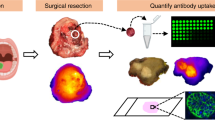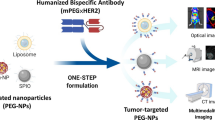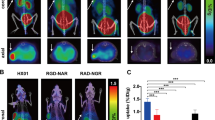Abstract
Purpose
The once highly anticipated antibody-based pathway-targeted therapies have not achieved promising outcomes for deadly pancreatic ductal adenocarcinoma (PDAC), mainly due to drugs’ low intrinsic anticancer activity and poor penetration across the dense physiological barrier. This study aims to develop an ultra-small-sized, EGFR/VEGF bispecific therapeutic protein to largely penetrate deep tumor tissue and effectively inhibit PDAC tumor growth in vivo.
Methods
The bispecific protein, Bi-fp50, was constructed by a typical synthetic biology method and labeled with fluorescent dyes for in vitro and in vivo imaging. Physicochemical properties, protein dual-binding affinity, and specificity of the Bi-fp50 were evaluated in several PDAC cell lines. In vitro quantitatively and qualitatively anticancer activity of Bi-fp50 was assessed by live/dead staining, MTT assay, and flow cytometry. In vivo pharmacokinetic and biodistribution were evaluated using blood biopsy samples and near-infrared fluorescence imaging. In vivo real-time tracking of Bi-fp50 in the local tumor was conducted by fibered confocal fluorescence microscopy. The subcutaneous PDAC tumor model was used to assess the in vivo antitumor effect of Bi-fp50.
Results
Bi-fp50 with an ultra-small size of 50 kDa (5 ~ 6 nm) showed an excellent binding ability to VEGF and EGFR simultaneously and had enhanced, accumulated binding capability for Bxpc3 PDAC cells compared with anti-VEGF scFv and anti-EGFR scFv alone. Additionally, bi-fp50 significantly inhibited the proliferation and growth of Bxpc3 and Aspc1 PDAC cells even under a relatively low concentration (0.3 µM). It showed synergistically enhanced therapeutic effects relative to two individual scFv and Bi-fp50x control in vitro. The half-life of blood clearance of Bi-fp50 was 4.33 ± 0.23 h. After intravenous injection, Bi-fp50 gradually penetrated the deep tumor, widely distributed throughout the whole tissue, and primarily enriched in the tumor with nearly twice the accumulation than scFv2 in the orthotopic PDAC tumor model. Furthermore, the Bi-fp50 protein could induce broad apoptosis in the whole tumor and significantly inhibited tumor growth 3 weeks after injection in vivo without other noticeable side effects.
Conclusion
The proof-of-concept study demonstrated that the ultra-small-sized, bispecific protein Bi-fp50 could be a potential tumor suppressor and an efficient, safe theranostic tool for treating PDAC tumors.







Similar content being viewed by others
Data Availability
The data that support the figures within this paper is available upon reasonable request.
Change history
01 February 2023
A Correction to this paper has been published: https://doi.org/10.1007/s00259-023-06128-0
References
Siegel RL, Miller KD, Fuchs HE, Jemal A. Cancer Statistics, 2021. CA Cancer J Clin. 2021;71:7–33.
Mizrahi JD, Surana R, Valle JW, Shroff RT. Pancreatic cancer. Lancet. 2020;395:2008–20.
Christenson ES, Jaffee E, Azad NS. Current and emerging therapies for patients with advanced pancreatic ductal adenocarcinoma: a bright future. Lancet Oncol. 2020;21:e135–45.
Neoptolemos JP, Kleeff J, Michl P, Costello E, Greenhalf W, Palmer DH. Therapeutic developments in pancreatic cancer: current and future perspectives. Nat Rev Gastroenterol Hepatol. 2018;15:333–48.
Tempero MA. NCCN Guidelines Updates: Pancreatic Cancer. J Natl Compr Canc Netw. 2019;17:603–5.
Rashid NU, Peng XL, Jin C, Moffitt RA, Volmar KE, et al. Purity Independent Subtyping of Tumors (PurIST), A Clinically Robust, Single-sample Classifier for Tumor Subtyping in Pancreatic Cancer. Clin Cancer Res. 2020;26:82–92.
Collisson EA, Bailey P, Chang DK, Biankin AV. Molecular subtypes of pancreatic cancer. Nat Rev Gastroenterol Hepatol. 2019;16:207–20.
Shi Y, Gao W, Lytle NK, Huang P, Yuan X, Dann AM, et al. Targeting LIF-mediated paracrine interaction for pancreatic cancer therapy and monitoring. Nature. 2019;569:131–5.
Li YJ, Wu JY, Wang JM, Hu XB, Cai JX, Xiang DX. Gemcitabine loaded autologous exosomes for effective and safe chemotherapy of pancreatic cancer. Acta Biomater. 2020;101:519–30.
Deplanque G, Demarchi M, Hebbar M, Flynn P, Melichar B, et al. A randomized, placebo-controlled phase III trial of masitinib plus gemcitabine in the treatment of advanced pancreatic cancer. Ann Oncol. 2015;26:1194–200.
O’Neil BH, Scott AJ, Ma WW, Cohen SJ, Aisner DL, et al. A phase II/III randomized study to compare the efficacy and safety of rigosertib plus gemcitabine versus gemcitabine alone in patients with previously untreated metastatic pancreatic cancer. Ann Oncol. 2016;27:1180.
Ho WJ, Jaffee EM, Zheng L. The tumour microenvironment in pancreatic cancer — clinical challenges and opportunities. Nat Rev Clin Oncol. 2020;17:527–40.
Adiseshaiah PP, Crist RM, Hook SS, McNeil SE. Nanomedicine strategies to overcome the pathophysiological barriers of pancreatic cancer. Nat Rev Clin Oncol. 2016;13:750–65.
Deshaies RJ. Multispecific drugs herald a new era of biopharmaceutical innovation. Nature. 2020;580:329–38.
Weidanz J. Targeting cancer with bispecific antibodies. Science. 2021;371:996–7.
D. Slaga, D. Ellerman, T.N. Lombana, R. Vij, J. Li, et al. Avidity-based binding to HER2 results in selective killing of HER2-overexpressing cells by anti-HER2/CD3. Sci Transl Med. 2018; 10: eaat5775.
Yin W, Zhu J, Gonzalez-Rivas D, Okumura M, Rocco G, et al. Construction of a Novel Bispecific Antibody to Enhance Antitumor Activity against Lung Cancer. Adv Mater. 2018;30:1805437.
Cox AD, Fesik SW, Kimmelman AC, Luo J, Der CJ. Drugging the undruggable RAS: Mission Possible? Nat Rev Drug Discov. 2014;13:828–51.
Goel HL, Mercurio AM. VEGF targets the tumour cell. Nat Rev Cancer. 2013;13:871–82.
Tortora G, Ciardiello F, Gasparini G. Combined targeting of EGFR-dependent and VEGF-dependent pathways: rationale, preclinical studies and clinical applications. Nat Clin Pract Oncol. 2008;5:521–30.
Hung MS, Chen IC, Lin PY, Lung JH, Li YC, Lin YC, et al. Epidermal growth factor receptor mutation enhances expression of vascular endothelial growth factor in lung cancer. Oncol Lett. 2016;12:4598–604.
Saito H, Fukuhara T, Furuya N, Watanabe K, Sugawara S, et al. Erlotinib plus bevacizumab versus erlotinib alone in patients with EGFR-positive advanced non-squamous non-small-cell lung cancer (NEJ026): interim analysis of an open-label, randomised, multicentre, phase 3 trial. Lancet Oncol. 2019;20:625–35.
Jain RK. Normalization of Tumor Vasculature: An Emerging Concept in Antiangiogenic Therapy. Science. 2005;307:58–62.
Tong RT, Boucher Y, Kozin SV, Winkler F, Hicklin DJ, Jain RK. Vascular Normalization by Vascular Endothelial Growth Factor Receptor 2 Blockade Induces a Pressure Gradient Across the Vasculature and Improves Drug Penetration in Tumors. Cancer Res. 2004;64:3731–6.
Erkan M, Hausmann S, Michalski CW, Fingerle AA, Dobritz M, Kleeff J, Friess H. The role of stroma in pancreatic cancer: diagnostic and therapeutic implications. Nat Rev Gastroenterol Hepatol. 2012;9:454–67.
Cabral H, Matsumoto Y, Mizuno K, Chen Q, Murakami M, et al. Accumulation of sub-100 nm polymeric micelles in poorly permeable tumours depends on size. Nat Nanotechnol. 2011;6(12):815–23.
Wang Q, Yan H, Jin Y, Wang Z, Huang W, et al. A novel plectin/integrin-targeted bispecific molecular probe for magnetic resonance/near-infrared imaging of pancreatic cancer. Biomaterials. 2018;183:173–84.
Wang Q, Yan H, Wang Z, Li Z, et al. Construction of a novel bispecific fusion protein to enhance targeting for pancreatic cancer imaging. Biomaterials. 2020;255: 120161.
Tang L, Yang X, Yin Q, Cai K, Wang H, Chaudhury I, et al. Investigating the optimal size of anticancer nanomedicine. Proc Natl Acad Sci. 2014;111:15344–9.
H. Soo Choi, W. Liu, P. Misra, E. Tanaka, J.P. Zimmer, B. Itty Ipe, M.G. Bawendi, J.V. Frangioni. Renal clearance of quantum dots. Nat Biotechnol. 2007; 25: 1165–1170.
Ogata G, Ishii Y, Asai K, Sano Y, Nin F, Yoshida T, et al. A microsensing system for the in vivo real-time detection of local drug kinetics. Nat Biomed Eng. 2017;1:654–66.
Fan Z, Sun L, Huang Y, Wang Y, Zhang M. Bioinspired fluorescent dipeptide nanoparticles for targeted cancer cell imaging and real-time monitoring of drug release. Nat Nanotechnol. 2016;11:388–94.
Le X, Nilsson M, Goldman J, Reck M, Nakagawa K, et al. Dual EGFR-VEGF Pathway Inhibition: A Promising Strategy for Patients With EGFR-Mutant NSCLC. J Thorac Oncol. 2021;16:205–15.
Lu Z, Weniger M, Jiang K, Boeck S, Zhang K, Bazhin A, Miao Y, Werner J, D’Haese JG. Therapies Targeting the Tumor Stroma and the VEGF/VEGFR Axis in Pancreatic Ductal Adenocarcinoma: a Systematic Review and Meta-Analysis. Target Oncol. 2018;13:447–59.
Von Hoff DD, Ervin T, Arena FP, Chiorean EG, et al. Increased Survival in Pancreatic Cancer with nab-Paclitaxel plus Gemcitabine. N Engl J Med. 2013;369:1691–703.
Gunturu KS, Yao X, Cong X, Thumar JR, Hochster HS, Stein SM, Lacy J. FOLFIRINOX for locally advanced and metastatic pancreatic cancer: single institution retrospective review of efficacy and toxicity. Med Oncol. 2012;30:361.
Grünwald BT, Devisme A, Andrieux G, Vyas F, et al. Spatially confined sub-tumor microenvironments in pancreatic cancer. Cell. 2021;184:5577-5592.e18.
Kindler HL, Niedzwiecki D, Hollis D, Sutherland S, et al. Gemcitabine Plus Bevacizumab Compared With Gemcitabine Plus Placebo in Patients With Advanced Pancreatic Cancer: Phase III Trial of the Cancer and Leukemia Group B (CALGB 80303). J Clin Oncol. 2010;28:3617–22.
Rougier P, Riess H, Manges R, Karasek P, Humblet Y, et al. Randomised, placebo-controlled, double-blind, parallel-group phase III study evaluating aflibercept in patients receiving first-line treatment with gemcitabine for metastatic pancreatic cancer. Eur J Cancer. 2013;49:2633–42.
Kindler HL, Ioka T, Richel DJ, Bennouna J, et al. Axitinib plus gemcitabine versus placebo plus gemcitabine in patients with advanced pancreatic adenocarcinoma: a double-blind randomised phase 3 study. Lancet Oncol. 2011;12:256–62.
Kindler HL, Wroblewski K, Wallace JA, et al. Gemcitabine plus sorafenib in patients with advanced pancreatic cancer: a phase II trial of the University of Chicago Phase II Consortium. Invest New Drugs. 2012;30:382–6.
Chen X, Zeh HJ, Kang R, Kroemer G, Tang D. Cell death in pancreatic cancer: from pathogenesis to therapy. Nat Rev Gastroenterol Hepatol. 2021;18:804–23.
Fang J, Feng L, Meng L, Wang X, Liu H, et al. A novel 18F-labeled agonist for PET imaging of stimulator of interferon gene expression in tumor-bearing mice. Eur J Nucl Med Mol Imaging. 2022;50:27–37.
Li C, Liu J, Yang X, Yang Q, Huang W, et al. Theranostic application of 64Cu/177Lu-labeled anti-Trop2 monoclonal antibody in pancreatic cancer tumor models. Nucl Med Mol Imaging. 2022;50:168–83.
S.C. Lee, J.S.Y. Ma, M.S. Kim, et al. A PSMA-targeted bispecific antibody for prostate cancer driven by a small-molecule targeting ligand. Sci Adv. 2021; 7: eabi8193.
Seung E, Xing Z, Wu L, Rao E, et al. A trispecific antibody targeting HER2 and T cells inhibits breast cancer growth via CD4 cells. Nature. 2022;603:328–34.
Brinkmann U, Kontermann RE. Bispecific antibodies. Science. 2021;372:916–7.
Acknowledgements
We thank the technical support from the Multimodal Biomedical Imaging lab, the Institute of Automation, the Chinese Academy of Sciences, and the Cold Spring Biotech Co., Ltd. In addition, we thank Beijing Gegen Biotechnology Co., Ltd. for helping prepare and purify the scFv fragments and fusion protein. This work was supported by the National Key Research and Development Program of China (No. 2017YFA0205200), the National Natural Science Foundation of Youth Program of China (No. 81901813), and the CAMS Innovation Fund for Medical Sciences (No.2021-I2M-C&T-B-067). We also thank "BioRender" for the scheme organizing. Finally, H.Y. and S.H.Y. acknowledge support from the National Institutes of Health in the U.S. (R01-CA192878).
Author information
Authors and Affiliations
Contributions
Q.W., H.Y., J.T., and X.M.Z. discusses and convinced this project. H.Y. and Q.W. designed the experiments. Q.W. and Z.L. fabricated the Bi-fp50 protein. Q.W. and J.Y.W. performed the characterization, in vitro imaging, and therapy assessment. Q.W. developed the PDAC animal model. Q.W. and K.W. performed in vivo imaging experiments. Q.W. and J.Y.W. performed in vivo therapy experiments. F.Y.K. assisted in data analysis. Q. W., J.Y.W., and H.Y. prepared figures and wrote the manuscript with inputs from all co-authors.
Corresponding authors
Ethics declarations
Ethics approval
The current study does not include any studies associated with human participants. All animal studies were performed according to the guidelines of the Animal Care Committee of the Chinese Academy of Medical Sciences Tumor Hospital.
Conflict of interest
The authors declare no conflict of interest.
Additional information
Publisher's note
Springer Nature remains neutral with regard to jurisdictional claims in published maps and institutional affiliations.
This article is part of the Topical Collection on Oncology - General.
The original online version of this article was revised: The authors regret the mistakes of the assigned initial affiliations, mainly the affiliation of Hao Yan and Seok-Hyun Yun, during typesetting owing to the authors’ negligence. Furthermore, the authors apologize for the related confusion caused to readers.
The original article has been corrected.
Supplementary Information
Below is the link to the electronic supplementary material.
Rights and permissions
Springer Nature or its licensor (e.g. a society or other partner) holds exclusive rights to this article under a publishing agreement with the author(s) or other rightsholder(s); author self-archiving of the accepted manuscript version of this article is solely governed by the terms of such publishing agreement and applicable law.
About this article
Cite this article
Wang, Q., Wang, J., Yan, H. et al. An ultra-small bispecific protein augments tumor penetration and treatment for pancreatic cancer. Eur J Nucl Med Mol Imaging 50, 1765–1779 (2023). https://doi.org/10.1007/s00259-023-06115-5
Received:
Accepted:
Published:
Issue Date:
DOI: https://doi.org/10.1007/s00259-023-06115-5




